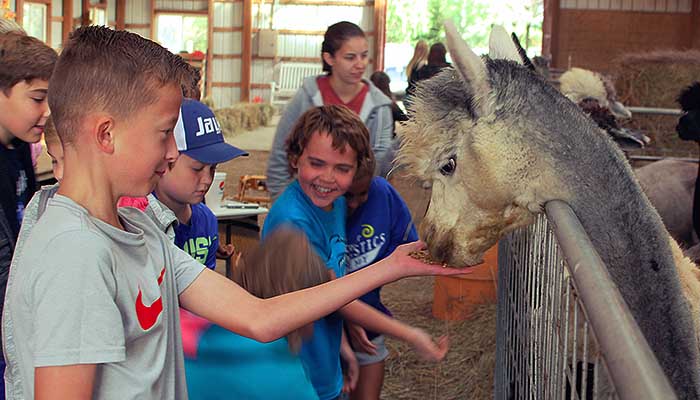
By CRISTINA JANNEY
Hays Post
Students fed alpacas, climbed into the cab of a tractor and ate popcorn all in the name of learning about agriculture during the 23rd annual Ellis County Farm Bureau Kids Ag Day at Pa’s Pumpkin Patch.
“Our goal for the day is to have kids have an on-farm experience,” said Audrey Werth, board member for the Ellis County Farm Bureau. “A lot of kids don’t get to be around animals or to be around crops and learn about that on a day-to-day basis. We enjoy having kids out her so they can learn about what farmers do, learn what’s in their food, and learn where other ag products come from.”
On Thursday, Hays USD 489 fifth-graders visited the pumpkin patch. Fourth-graders will visit Oct. 4.
The stations the students explored included beef, pumpkins, soil, soybeans, wheat, sunflowers, water conservation, water cycle, farm equipment, alpacas, corn and leaves.
Alpacas

Maggie Moeder, alpaca farm hand, talked to the students about care of the alpacas that live at the pumpkin patch as well as how their fleece is used.
Alpacas are known to spit. Generally they spit at other alpacas to let them know they are encroaching on their food. They make a high screeching sound as an alarm, Moeder said. In their native Peru, alpacas face many predators, but they don’t have many defenses.

Unlike other herd animals, alpacas don’t have hooves. They have soft pads on the bottoms of their feet similar to a dog’s paws.
Alpacas live to be about 20 years old. Alpacas are typically not slaughtered for their meat domestically, but it is served in high-end restaurants in South America.
Alpacas are shorn once a year. They are renowned for their fleece, which can be very warm. It is also hypoallergenic, whereas some people have allergies to wool. Moeder showed the students several examples of products made with alpaca fleece, including rugs, socks, scarves and earmuffs.
Farm safety
Chase Wagner, ag salesman with Carrico Implement, talked to the children about the importance of farm safety and explained several parts of a tractor.

He said you need to make eye contact with a implement operator so you know that the operator has seen you. If you are directly in front of the tractor, you can’t be seen.
“If you are around this machine, and he has not made eye-contact with you, he does not know you are there. … These are big machines, and there is a lot gong on in that cab,” Wagner said.
He also warned the children to avoid the area between the tires and body of the tractor, which can be pinch point if the tractor is in operation.
Corn

The students were surprised to learn about products that contain corn, including biodegradable packing peanuts, dog treats and Jolly Ranchers candy. The students dunked the packing peanuts in water and watched them dissolve.
“It feels weird,” one student said as he dunked the packing peanut in water.
The pellets the students fed to the alpacas earlier in the day also contain corn. Corn is an inexpensive source of sugar for animals, so it is often used in animal feed.
Stacy Campbell of the Cottonwood Extension District talked about growing corn, and each student received a clear pouch to wear around their necks that contained a kernel of corn and water beads Campbell said the moisture from the beads in combination with the students’ body heat should cause the corn to germinate.
“Farmers are needed, and their products are needed,” Campbell said. “They try to grow the corn as cheaply as they can, so they can make money.
“If they try to grow it as cheaply as they can, they don’t get carried away and put a bunch of pesticides out there. They put a very minimal amount of pesticides, just what the crops need. They only put the right amount of fertilizer on.”
The students also received bags of popcorn.



